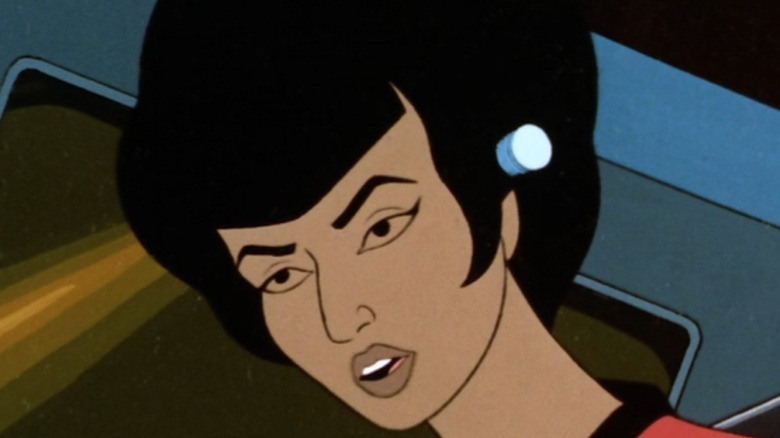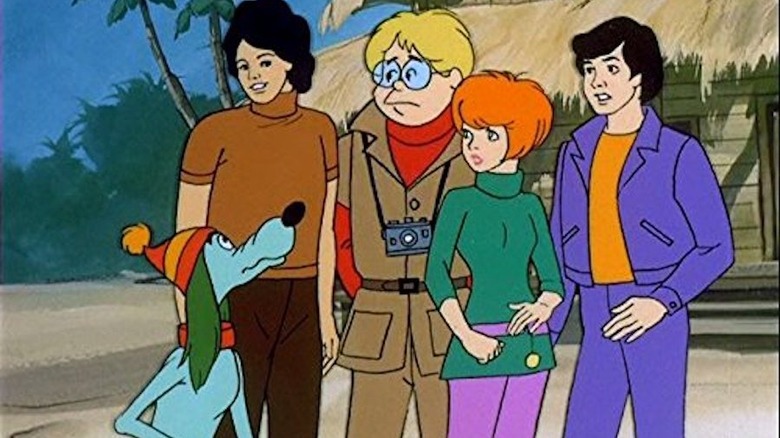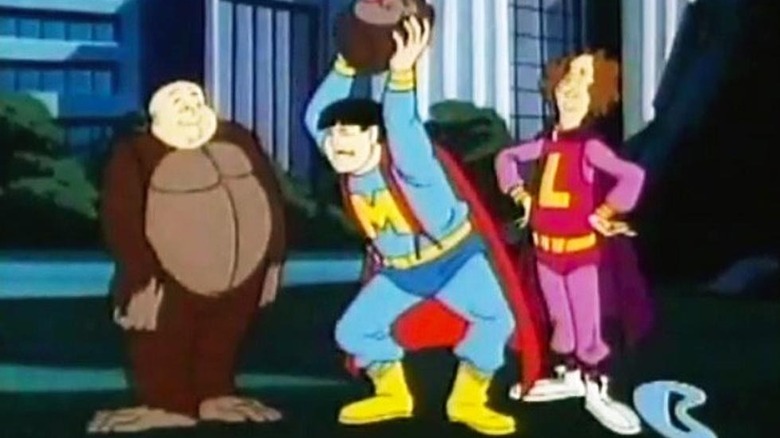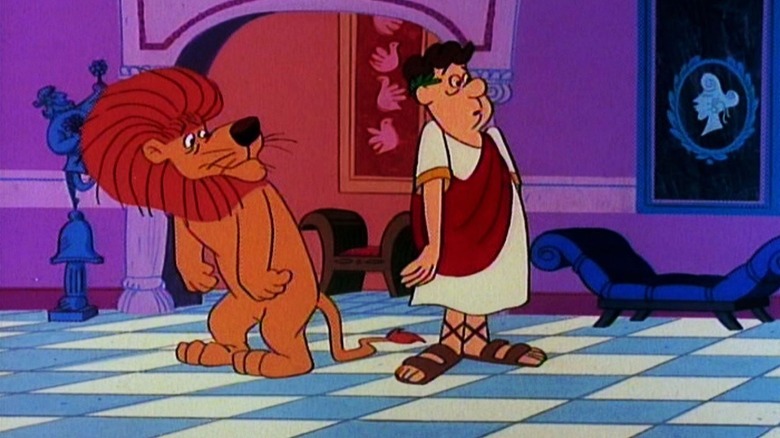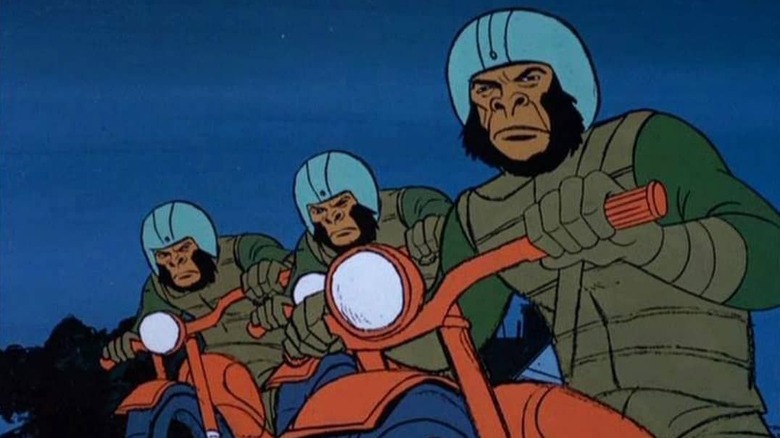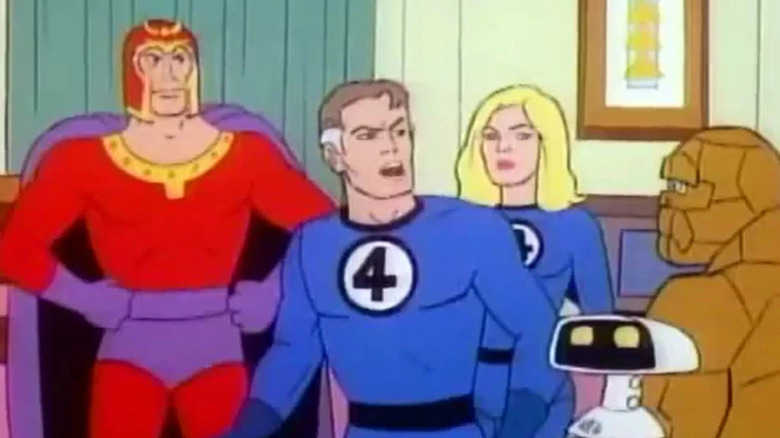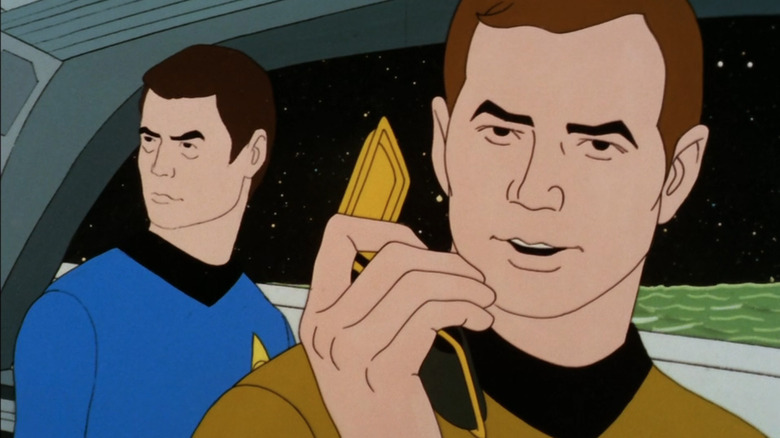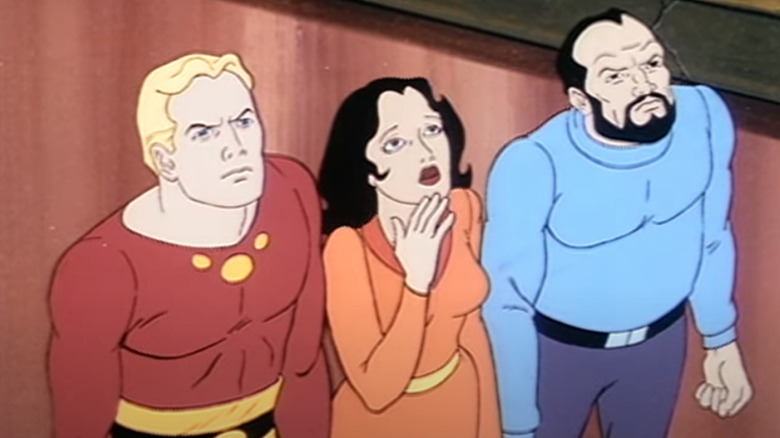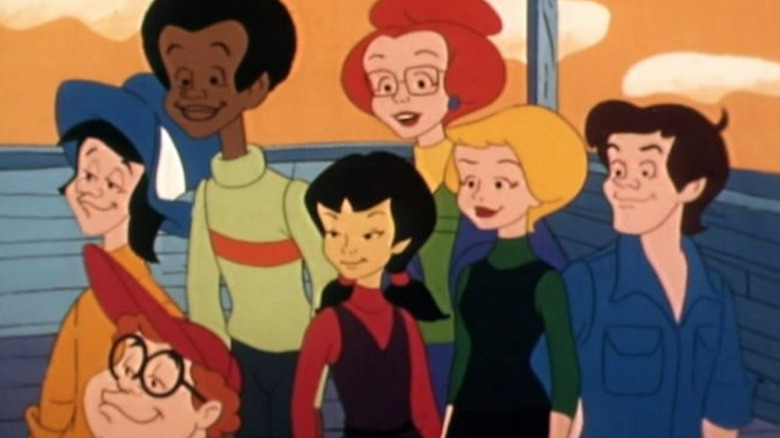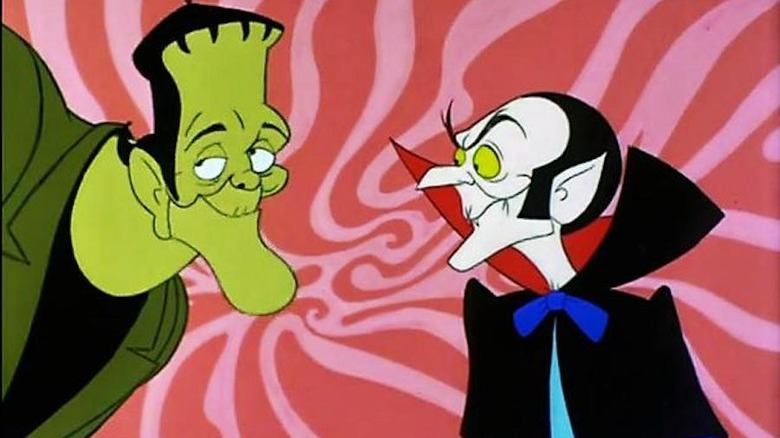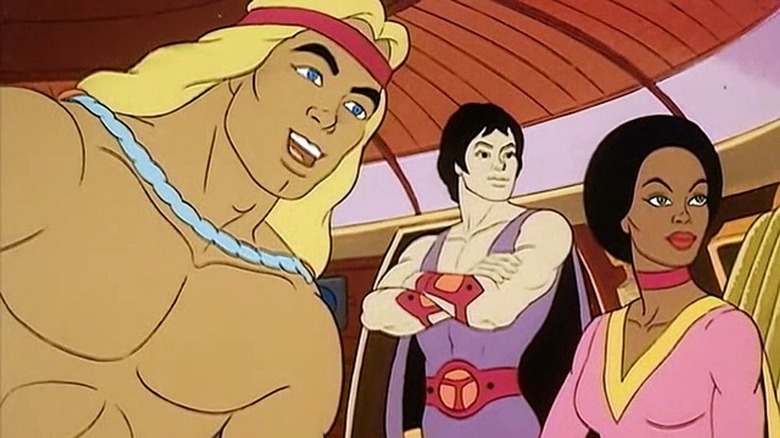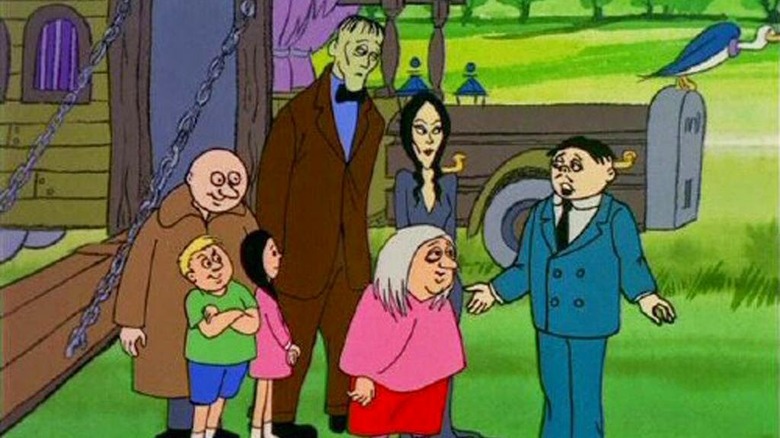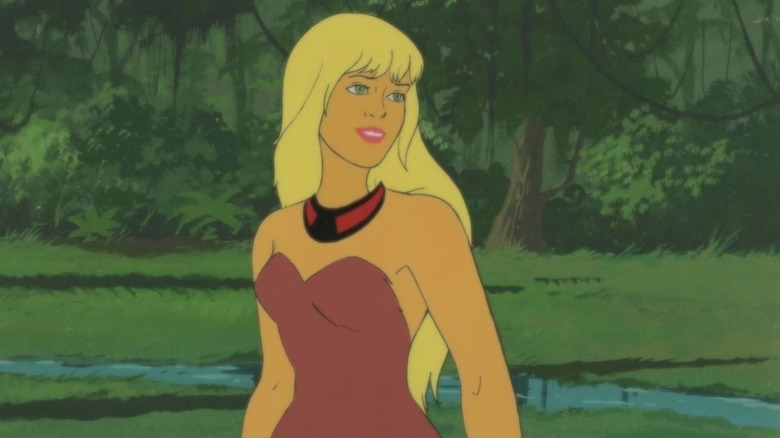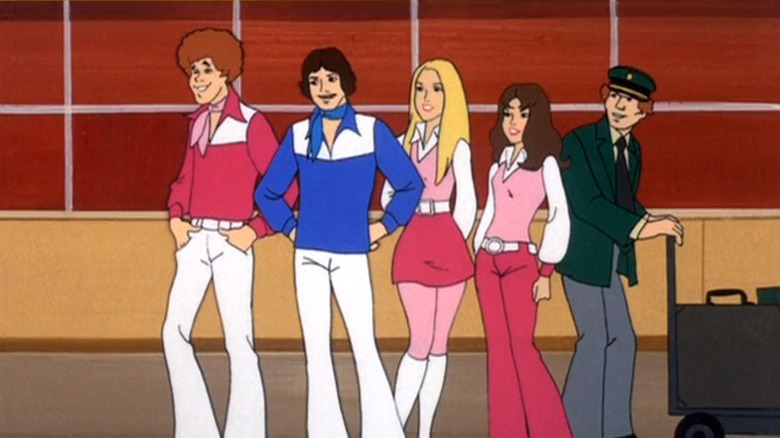Saturday Morning Cartoons From The '70s That You Need To Know About
Kids today will probably never know the joy of waking up early on a Saturday morning and rushing to turn on the television to watch cartoon adventures. For decades, it was a ritual repeated week after week that transfixed children across the country. The 1960s were the golden age of Saturday morning cartoons, with iconic classics like "The Flintstones," "Scooby-Doo," and "Underdog," but it was the 1970s that cemented the legacy of that early weekend programming.
Animation studios like Filmation and Hanna-Barbera dominated Saturday mornings in the 1970s. With each new hit, the shows got weirder and wackier, a testament to the strangeness of the decade. Maybe it was the nature of being animation pioneers, able to experiment and try new things, or maybe it was mind-altering awesome sauce, but there's a certain flavor to '70s cartoons that will never be matched.
Beyond the best of the era, there were many other shows that have been overlooked as the decades have gone on, and not a few unsung heroes of the 1970s have been forgotten. So pour yourself a bowl of Fruit Brute and plop your butt on the bean bag chair, because we're taking a stroll down memory lane. These are Saturday morning cartoons from the '70s that you need to know about.
Goober and the Ghost Chasers
After Hanna-Barbera had success with "Scooby-Doo, Where Are You?" they went back to that formula more than once. Though it's not talked up much anymore, one of them is the short-lived offering "Goober and the Ghost Chasers." Where "Scooby-Doo" had the gang investigating the supernatural and usually finding it in the work of ordinary villains, "Goober and the Ghost Chasers" saw a group of teens on the hunt for very real ghosts.
Goober is a talking dog who seems to be a mash-up of both Scooby-Doo and Shaggy, an overly frightened mutt with a very hippie-like vibe who turns invisible when he gets scared. When he can be seen, Goober leads a team that includes teen reporters Ted and Tina as well as their faithful photographer Gilly. Together they look into strange occurrences for Ghost Chasers Magazine. With the help of specialized ghost-detecting equipment, they meet all manner of monsters.
As was common for the era, several episodes featured crossovers with other shows, including "The Partridge Family" more than once, while another episode saw the kids meet NBA superstar Wilt Chamberlain. A fun little adventure that doesn't get nearly enough credit, "Goober and the Ghost Chasers" is often overlooked as a mere "Scooby-Doo" knockoff. Between the ghost hunting and the kids' special equipment, it has shades of "Ghostbusters," but predates the 1975 live-action series "The Ghost Busters."
The Robonic Stooges
The 1970s saw franchise fare on the rise. Every network seemed to be producing animated spin-offs and revivals with weird new twists. This led to a strange trend of anachronistic sci-fi mash-ups like "The Partridge Family 2200 A.D." and "Josie and the Pussycats in Outer Space." Such was the case with "The Robonic Stooges," a series that took the iconic "Three Stooges" comedy troupe and put them into a sci-fi superhero adventure where they've become cyborg secret agents.
"The Robonic Stooges" has its origins on a variety show of sorts called "The Skatebirds," but after its cancelation in 1978, the segment got its own standalone series. In a show that could only have been dreamt up in a grass-fueled haze, we meet the Three Stooges — Moe, Larry, and Curly — as superheroes who live in a junkyard and have strange bionic powers. They work for the Superhero Employment agency under the orders of Agent 000, who sends them on a variety of missions across the globe and even through time.
The Three Stooges encounter witches, genies, and Hercules himself, adventuring in Ancient Greece, Atlantis, and the Klondike, just for starters. Though it's not as good as the best Hanna-Barbera had to offer, it's a goofy superhero adventure that has to be seen to be believed.
The Roman Holidays
Just as Hanna-Barbera turned their own "Scooby-Doo" concept into "Goober and the Ghost Chasers," the 1972 series "The Roman Holidays" is a new spin on an old classic. Borrowing the concept of previous hits "The Flinstones" and "The Jetsons," the series showcases the exploits of an ordinary family in an extraordinary era.
In this case, "The Roman Holidays" follows August Holiday and his family and their everyday adventures living in Roman antiquity. The conflict centers on their tyrannical landlord at the Venus DeMilo Arms Apartments, the aptly named Mr. Evictus, who's always threatening to toss them out. Augustus lives with his wife Laurie, his children Happius and Precocia, and their pet lion Brutus. Their neighbors Herman and Henrietta live with their hippie daughter Groovia.
Sure, the names are goofy, but that's all part of the fun, with a blend of '70s culture and an Ancient Roman setting that makes for a wonderfully wacky series. Though it only aired 13 episodes, it's nearly as good as "The Flinstones," with many of the same charms.
Return to the Planet of the Apes
The groundbreaking 1968 sci-fi adventure "Planet of the Apes" tore up the box office and left its mark on pop culture with one of the most jaw-dropping final twists in Hollywood history. In the following years, four sequels came in quick succession, before a live-action spinoff arrived in 1974. Due to television budget limitations, it couldn't match the movie's look and feel, and failed to wow audiences. A year later, they turned to Saturday mornings with "Return to the Planet of the Apes."
The title may sound like a sequel, but the series is more of a total reboot. It centers on three astronauts, Bill Hudson, Jeff Allen, and Judy Franklin, who find themselves on an upside-down planet where mute humans are slaves in an ape-run society. Several of the ape characters from the films are reimagined, including Cornelius, Zira, Dr. Zaius, and General Urko, as well as the human woman Nova.
While the voice acting is stiff and the animation can be clunky, the stories are effective. Exploring surprisingly relevant social issues for a kid's cartoon, the series successfully carries the torch of the original movies. Admittedly, the series came a few years too late to capitalize on the success of the films, and its conclusion after 13 episodes marked the end of the original "Planet of the Apes" era on screen.
The New Fantastic Four
Debuting in 1961, "The Fantastic Four" established themselves as one of the best super-teams in comics. Their first cartoon series arrived just a few years later in 1967 in a faithful adaptation of their adventures on the page. In the 1970s, a new cartoon came on Saturday mornings called "The New Fantastic Four." While it's well-known by comic book aficionados, it's often dismissed, partly due to the absence of Johnny Storm — AKA The Human Torch — and the presence of his goofy robot replacement H.E.R.B.I.E.
Despite what the urban legend would have you believe, the diminutive robot wasn't included because the network was concerned about The Human Torch prompting kids to play with matches. Instead, it was a complicated rights issue that resulted in the creation of the robot assistant, who eventually went on to be introduced into the main Marvel Universe in the comics. The series itself is a faithful, if somewhat more lighthearted adventure, and gets high marks for digging deep into the well of Marvel's villainous pantheon.
Over the course of its single-season run, the FF went up against not only Doctor Doom and Magneto but also several "Spider-Man" villains like The Sandman and The Trapster, as well as more obscure baddies like The Impossible Man and The Wizard. All in all, "The New Fantastic Four" is a fun adaptation. It's a product of its time, but doesn't deserve the derision it sometimes gets.
Star Trek: The Animated Series
Though the original run of "Star Trek" left the air in 1969, the series saw new life in reruns during the next decade. While creator Gene Roddenberry negotiated for a live-action revival, low-budget animation studio Filmation launched a children's cartoon spin-off. Running for two seasons and 22 episodes, "Star Trek: The Animated Series" has become the black sheep of the franchise, but diehard Trekkies have always had a soft spot for the series. Today, the awkwardly stiff animation, recycled imagery, and stock sequences make it awkward, but it deserves more credit for what it got right.
Benefitting from the 1974 writer's strike that didn't affect animation, the series secured the services of several of the writers of the original TV show (via Cartoon Research), while nearly the entire cast of actors returned to voice their roles. The animated format allowed the series to explore ideas that were impossible in live-action, which led to some ambitious stories, too. Ultimately, the series is a mixed bag, but includes several genuinely thought-provoking and compelling installments worthy of the best "Trek."
Though few will ever tell you it's great television, "Star Trek: The Animated Series" is an absolute must-watch for its sheer weirdness, with stories that embody everything that made 1970s cartoons so unique. Alien races with floating body parts, a clone of Mr. Spock that's 20 feet tall, and Satan matching wits with Captain Kirk make it a wild and zany romp.
The New Adventures of Flash Gordon
Created in the 1930s as a newspaper comic strip, "Flash Gordon" became a series of film serials that same decade and a live-action TV series in the 1950s that ran for nearly 40 episodes. Roughly 25 years later, he returned to television in "The New Adventures of Flash Gordon" in 1979. Like "Star Trek: The Animated Series," it used its animated format to full effect and helped reinvent the iconic hero for a new generation.
The series sees adventurer Flash Gordon, his girlfriend Dale Arden, and Dr. Zarkov leaving Earth in a rocket ship in an attempt to save the planet from certain doom. They arrive on the alien planet of Mongo and immediately clash with the world's villainous ruler, Ming the Merciless. Flash's hair-raising adventures boast real action and excitement and even some scantily clad women, making it surprisingly edgy for a Saturday morning kids' show.
While the first batch of episodes is high-quality — owing to the fact that they were originally produced as a film by "Star Trek" scribe Sam Peeples — further episodes see a precipitous decline. Nevertheless, it's still a fun adventure, and its first season is full of death-defying cliffhangers and nail-biting scrapes for Flash Gordon and friends. A fast-paced adventure story, it received a second season in 1980, the same year a live-action feature film landed in theaters.
Mission: Magic!
Stop us if you've heard this one before: an eccentric red-headed schoolteacher with magical powers takes a group of school children on adventures through time and space, teaching them lessons along the way. If you're thinking it's Mrs. Fizzle from "The Magic School Bus," think again: we're talking about Miss Tickle, a happy-go-lucky redheaded teacher and magician from the 1973 series "Mission: Magic!" Miss Tickle led a group of diverse school kids who were joined by an animated version of pop star Rick Springfield, for whom the show was ostensibly a TV vehicle.
Week after week, Springfield calls on the kids and Miss Tickle for help with some kind of mission. A magical door and a ceramic cat named Tut-Tut gave them a portal to the rock star and his pet owl Ptolemy, and together they go on various adventures through time and space. Stories include a jaunt to Ancient Egypt, where they fight Queen Nephren; a trip to Paris, where they apprehend a magician who stole a valuable statue; and an adventure in an underwater kingdom, where they contend with a dangerous villain called Dr. Manta.
Alongside the series, Rick Springfield released a soundtrack album, with full-length versions of songs that appeared in truncated form in each episode. While it might not be quite as good as "The Magic School Bus," it definitely deserves a watch.
Groovie Ghoolies
In what feels related to a series of classic Topps monster cards of the 1960s, "Groovie Goolies" aired in 1970 for just one 16-episode run. The alliteration-filled series revolved around the goings-on at Horrible Hall, a home for the titular Goolies, a group of friendly creatures who were all pastiches of iconic movie monsters. In addition to being based on pop culture characters like Dracula, Frankenstein, and Dr. Jekyll and Mr. Hyde, the monsters were musicians, and each episode featured musical numbers.
Though the mileage of the laughs may vary, the humor is deliciously pun-filled from top to bottom. The characters — including the beatnik werewolf Wolfie, a medic mummy, and a female phone operator named Bella La Ghostly — lived in Horrible Hall alongside living furniture like the Ask-It-Casket and the Lovesick Loveseat. The monsters' music was the highlight of each episode, with vampire Drac playing the organ, Frankie the Monster on drums, and Wolfie strumming a kind of guitar.
In addition to its 16 episodes, "Groovy Goolies" became part of "Sabrina the Teenage Witch" that same year, appearing in 16 animated shorts. They even made a brief comeback in 1977 for two episodes of "The New Archie and Sabrina Hour," and popped up in a movie crossover with the Looney Tunes.
Space Sentinels
The hottest Saturday morning cartoon in the 1970s might have been "Super Friends," the DC Comics team-up show that featured a roster of all the best superheroes. Not to be outdone, rival network NBC launched their own superhero team series in 1977 titled "Space Sentinels." But rather than featuring animated adaptations of popular comic book heroes, the series is an original creation inspired by mythical heroes of legend. The team's roster includes Hercules and Mercury from Roman mythology and Astrea, the namesake of a Greek deity.
The team began with three ordinary humans taken from Earth centuries ago and given superhuman abilities and immortality. Now they're returned in the modern day to become the planet's protectors, who, with the aid of a powerful spaceship, ward off all manner of dangerous threats. Hercules of course has super-strength, while Mercury has super-speed, flight, and martial arts skills. Astrea can shape-shift into any animal she chooses. Together with a robot named Moe and the artificial intelligence Sentinel One aboard their ship, they battle with the Norse god Loki, diabolical space invaders, and villainous time travelers.
A mix of "Star Wars" and "Super Friends," the series was a strong adventure show for kids that also exposed them to history and mythology. It also featured episodes with important messages and unexpectedly serious stories, too.
The Addams Family
"The Addams Family" began life as a series of single-panel cartoons in the New Yorker, but it was the live-action 1964 television series that put it on the pop culture map. Running for two seasons, it had an iconic theme tune and became a staple in reruns for decades. Like "Star Trek" before it, the series was revived in animation first, but it didn't go straight to series. Instead, the family popped up in an episode of "The New Scooby-Doo Movies" from 1972 titled "Wednesday Is Missing."
While that episode had featured the original cast of the 1960s TV show, the eventual spin-off animated series that aired a year later only featured Jackie Coogan and Ted Cassidy back as Uncle Fester and Lurch. A faithful reinterpretation of the original cartoons in style if not in substance, the Saturday morning cartoon sees the family hit the road and travel to a new destination each week. During their adventures, the Addams family visits New Orleans for Mardis Gras, Chicago for a pie-eating contest, and Cape Kennedy for a trip to the moon (this was the 1970s, after all).
Notably, a very young Jodie Foster voiced Pugsley Addams. Thanks to production by Hanna-Barbera, it also boasted strong animation. The show spawned a line of merchandise, including a board game, and was used as the springboard for a series of public service announcements.
Jana of the Jungle
If you haven't spotted the trend by now, the 1970s was an era of copycats. When Filmation found success with "Tarzan, Lord of the Jungle" in 1976 — which lead to years of stories for the character that continued into the '80s — Hanna-Barbera swung into action and created "Jana of the Jungle," centered on a beautiful woman living in the jungle with a variety of animal friends.
Though it only ran for 13 episodes between September and December of 1978, "Jana of the Jungle" stands out with superior animation, fun stories, and exciting action. Jana is introduced as the daughter of an explorer who got lost in the jungles of South America when she was very young. As an adult, she travels to the region in an attempt to find him. She is joined by Dr. Ben Cooper, a scientist who helps in her search; Montaro, an indigenous warrior with a magical staff; and Ghost, a faithful albino jaguar.
A new take on the classic "jungle girl" trope, "Jana of the Jungle" is a true woman of the '70s: strong, courageous, kind, and noble. With both "Tarzan" and "Wonder Woman" popular in the era, the series mixes elements of both to create a special show that has sadly been overlooked over the years, if not entirely forgotten.
Butch Cassidy and the Sundance Kids
If you're expecting a wacky Saturday morning cartoon reinvention of the iconic Robert Redford/Paul Newman Western, think again. This is the 1970s we're talking about, where anything goes and nobody plays by the rules. As such, "Butch Cassidy and the Sundance Kids" is instead a musical adventure series about an entirely unrelated young rock group, the titular Sundance Kids, led by fictional teen idol Butch Cassidy. By day the kids go on tour as pop stars, and by night adventure as intrepid crime fighters working for a clandestine government agency in highly dangerous missions that take them all over the world.
Like any good secret agents, they are aided in their missions by a supercomputer, this one named Mr. Socrates, and have a faithful canine companion named Elvis. Each week, the Sundance Kids would meet in a secret lair to receive their orders. They then head out to stop vile villains, thwarting everything from kidnapping plots to jewel heists. Always full of high adventure and head-bopping music, the kids went from the Caribbean to Hong Kong and from Hawaii to the British Isles.
Another show that didn't last beyond a single short season, "Butch Cassidy and the Sundance Kid" did find a long legacy. Decades later, Butch and the band would show up several times as part of Cartoon Network's tongue-in-cheek throwback series "Sealab 2021."
